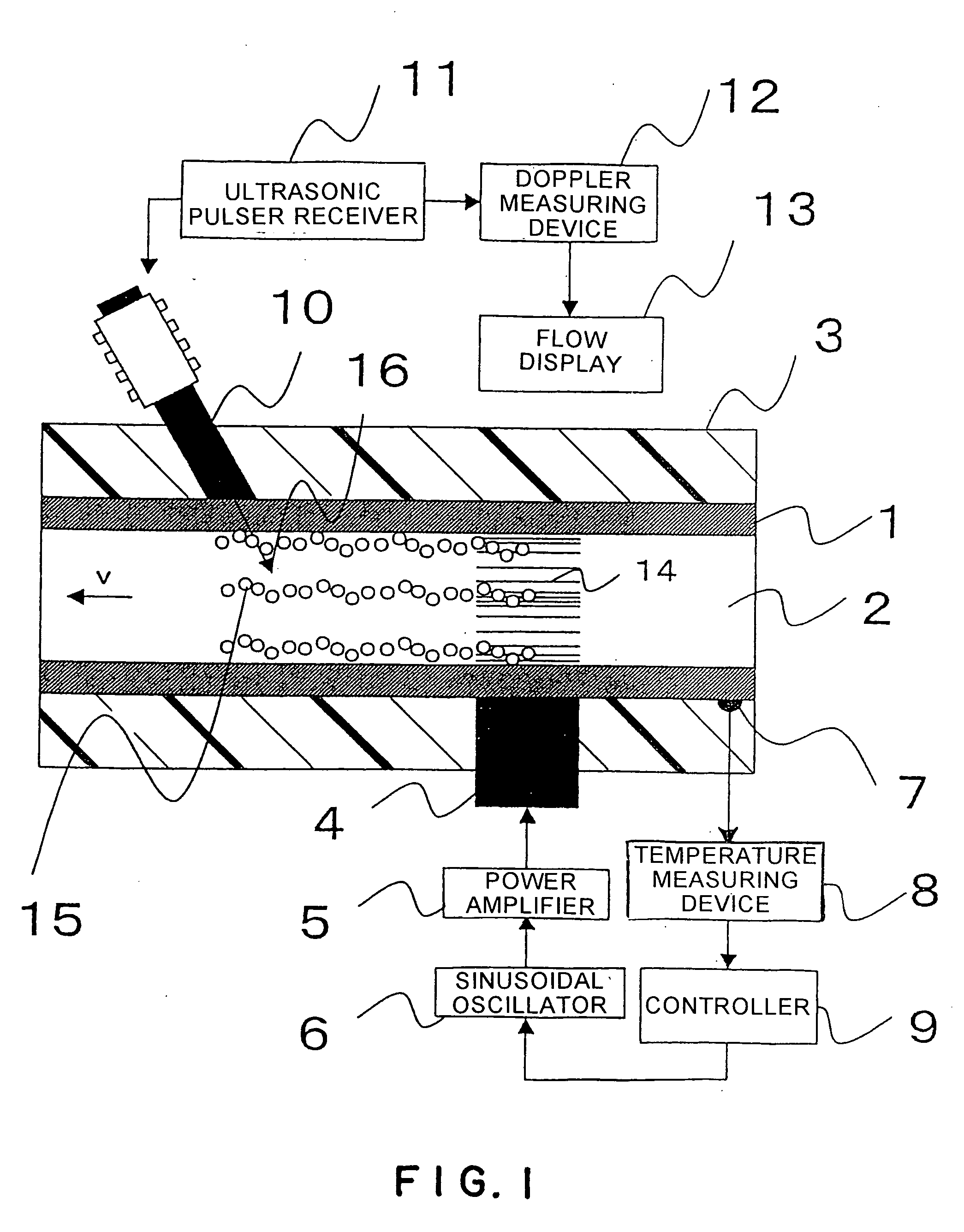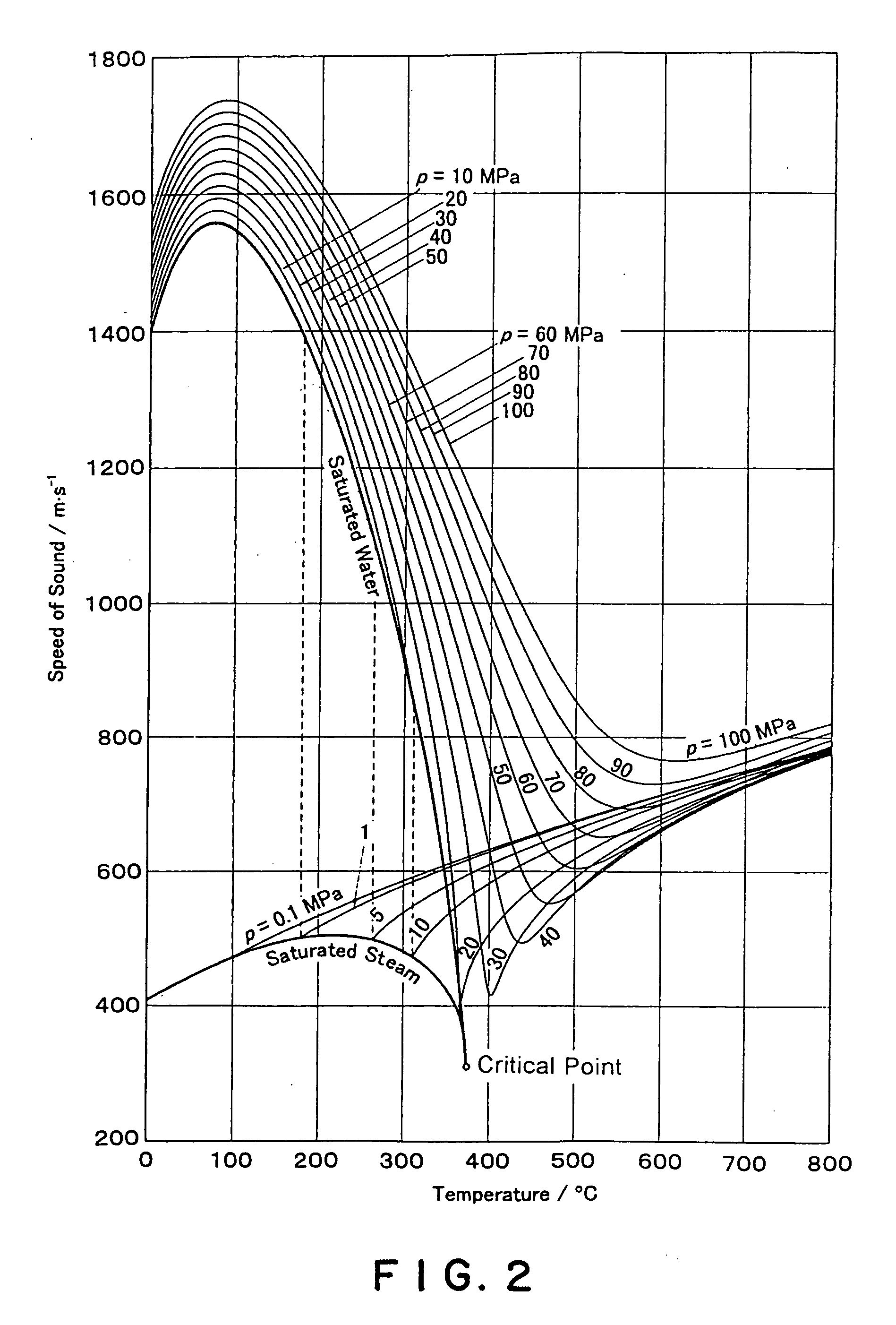Ultrasonic cavitating apparatus and ultrasonic doppler flow measurement system
- Summary
- Abstract
- Description
- Claims
- Application Information
AI Technical Summary
Benefits of technology
Problems solved by technology
Method used
Image
Examples
first embodiment
[0026]FIG. 1 is a schematic cross-sectional view of an ultrasonic flow measurement system in a first embodiment according to the present invention. A high-temperature fluid 2 flows through a pipe 1. The pipe 1 is wrapped in a heat insulator 3. An ultrasonic transducer 4 for causing cavitation is mounted to the pipe 1. The ultrasonic transducer 4 is connected to a power amplifier 5. The power amplifier 5 is connected to a variable-frequency, sinusoidal wave oscillator 6. A temperature sensor 7 is attached to the pipe 1 to measure the temperature of the high-temperature fluid 2. The temperature sensor 7 is connected to a temperature measuring device 8, which is connected to a controller 9. The controller 9 is connected to the sinusoidal wave oscillator 6. The devices 4, 5, 6, 7, 8 and 9 constitute a cavitating section of the system.
[0027] An ultrasonic sensor 10 for flow measurement, or a measuring ultrasonic transducer, is attached to the pipe 1. Usually, the ultrasonic sensor 10 is...
second embodiment
[0043]FIG. 5 is a view of a second embodiment according to the present invention. The embodiment shown in FIG. 5 differs from the embodiment shown in FIG. 1 in the increased number of ultrasonic transducers for causing cavitation.
[0044] As shown in FIG. 5, an additional ultrasonic transducer 4′ is arranged such that the ultrasonic transducers 4 and 4′ are disposed diametrically opposite to each other on a pipe 1. The ultrasonic transducer 4′ is connected to a power amplifier 5′. The power amplifier 5′ is connected to a sinusoidal oscillator 6′. The sinusoidal oscillator 6′ is also connected to the controller 9. In this embodiment, the controller 9 controls the sinusoidal oscillators 6 and 6′ on the basis of measured data provided by a temperature sensor 7 and a temperature measuring device 8 so that the ultrasonic oscillators 6 and 6′ generate signals of different frequencies, respectively, to generate a standing wave in a fluid 2 in the pipe 1.
[0045] When a frequency as high as a...
third embodiment
[0047]FIG. 7 shows a third embodiment according to the present invention. The embodiment shown in FIG. 7 differs from the embodiment shown in FIG. 1 only in that an ultrasonic delaying material 20, which is made of a material identical to that of the pipe 1, is interposed between an ultrasonic transducer 4 for causing cavitation and the outer surface of the pipe 1. Thus, the energy of an ultrasonic wave can be efficiently transmitted to a fluid through a complex resonance generated between the delaying member 20 and the wall of the pipe 1. According to “Cho-Ompa Gijutu Binran”, Saneyoshi et al., The Nikkan Kogyo Shimbun Ltd., transmittance is improved when the thickness of the delaying material 20 is equal to an odd number times the half wavelength of the ultrasonic wave. In the second embodiment shown in FIG. 5, ultrasonic delaying material 20 may be combined with the two ultrasonic transducers 4 and 4′, respectively, to enhance the sound pressure of the ultrasonic wave in the flui...
PUM
 Login to View More
Login to View More Abstract
Description
Claims
Application Information
 Login to View More
Login to View More - Generate Ideas
- Intellectual Property
- Life Sciences
- Materials
- Tech Scout
- Unparalleled Data Quality
- Higher Quality Content
- 60% Fewer Hallucinations
Browse by: Latest US Patents, China's latest patents, Technical Efficacy Thesaurus, Application Domain, Technology Topic, Popular Technical Reports.
© 2025 PatSnap. All rights reserved.Legal|Privacy policy|Modern Slavery Act Transparency Statement|Sitemap|About US| Contact US: help@patsnap.com



